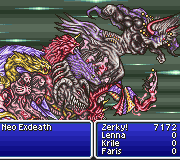|
Alpha Centauri let you terraform.  Booo Beyond Earth. Booooooo.
|
|
|
|

|
| # ? Jun 15, 2024 20:58 |
|
Really no way to melt ice caps? Humanity managed to do it on Earth, surely they can do it again.
|
|
|
|
|
Nope. Nor any way to put explorer modules on a submarine even though the animation for explorers investigating underwater expedition sites is launching a minisub. Also, since it may be of interest to some folks, here's how I came up with the various minor sponsors we saw throughout this game: I rolled a d12 for it. Seriously. I made up a list of minor sponsors that weren't in the game, and had intended to use them exclusively for wrecked colony lander sites. Given Al Falah's backstory, I ended up also using the list for derelict settlements there at the beginning of the game. And, well, we all know how that went. Here was my original list of 12 minor sponsors and the rolls we got: 1. United States of America (the federal government, not ARC) 2. Mexico (the Tlaloc Initiative) 3. Colombia 4. Argentina 5. Netherlands 6. Italy 7. Portugal 8. Egypt 9. Ethiopia 10. Japan (the Amaterasu Foundation) 11. Thailand 12. The Philippines 1, 2, 5, and 10 ended up getting used for this playthrough and will need to be replaced if I'm going to do a second game as I intend. I'm open to suggestions.
|
|
|
|
Some kind of Greenland-Canada union?
|
|
|
|
|
Cythereal posted:I'm open to suggestions. Apple, Amazon, WalMart, or Microsoft
|
|
|
|
West Africa/Songhai, Vietnam-Cambodia
|
|
|
|
The International Committee of the Red Cross or some other prominent NGO that were forced into governing refugees as a society rather than let them starve.
|
|
|
|
Cythereal posted:Welp. I can't save that wrecked lander after all. Only combat units can use the phasal transporter, and explorers aren't considered combat units. You could you use something like this mod to spawn an explorer, clear the wreck, then disband the spawned explorer and fluff that you transported it with a submarine.
|
|
|
|
Let's catch up on the civlopedia some, too, while I sit in roulette queues.Vertical Farming posted:As developed on this world, vertical farming took the form of rounded skyscraper greenhouses, where sunlight could be augmented with artificial lighting to promote photosynthesis in crops. Built upon microbiologist Dickson Despommier’s 2010 AD designs, the domes use water and nutrient recycling systems powered by externally mounted solar panels and wind turbines to accelerate growth in soilless cultivation. The advantages to vertical farming in the mode practiced by the colonies are numerous: protection from the vagaries of this planet’s weather and climate, conservation of scarce mineral resources, increased yield, less need for herbicides, fungicides and pesticides, as well as other benefits. A number of colonial settlements have come to depend on their domes for all manner of food and pharmacological plants, and would be much smaller without these. Synthetic Thought posted:In the first decade of the 21st Century on Old Earth, researchers in the then-United States and Japan designed a synthetic synapse that mimicked the function of an organic one. The Great Mistake brought a hiatus to developments in “synthetic thought,” as science was turned to dealing with more immediate concerns. Colonial scientists eventually perfected the original design, creating a silver-sulfide, nanoscale synapse that enabled both short- and long-term memory to a degree never seen before. The activity of synthetic thought conforms to psychological nodes of human memory, allowing for replication of human cognition in terms of analysis and judgment. These artificial synapses, although costly and delicate, are now used in a variety of ways, implanted into human brains to improve performance and integrated into computer networks to heighten artificial intelligence. Whether in human augmentation or computer biomimicry, research in synthetic thought has opened new horizons for social progress on this world. Collaborative Thought posted:Derived in part from the systems theories of von Bertalanffy and Ashby, in part from the sociocracy systems of the late 20th Century, in part from the “Delphi” method of problem solving pioneered by the RAND Corporation on Old Earth, “collaborative thought” makes use of brain-computer informatics interfaces to foster artistic and rationalist creativity. Initially conceptualized by early colonial philosophers, collaborative thought was seized upon by colonial administrators as a working method to resolving the many challenges facing their settlements. By bringing together leading scientists, artists, military officers, businessmen and others, it was believed that imaginative solutions could be offered, evaluated and implemented much quicker than before. A collateral benefit, according to some, was the fostering of groupthink among their citizenry. Climate Control posted:While climate control on Old Earth became a topic of great interest in the climatological chaos that followed the Great Mistake, little practical research was accomplished. However, after several generations had passed in Mankind’s tenure on this world, a number of colonial scientists turned their attention to the possibilities of inducing limited weather change in small areas. Although methods for inducing troposphere- and stratosphere-level changes had been long understood, the technology required did not exist. But small-scale methods – such as cool roofing, cloud reflectivity enhancement, cloud seeding, bio-precipitation, high-albedo crops and foehn arrays – could be used to affect temperature, atmospheric moisture, wind velocities and the like over geographically contained regions. Through combinations of such projects, colonies have been able to convert some areas from desert, swamp and tundra to more amenable terrain types. Augmentation posted:Colonial bioethicists restrict the phrase “human augmentation” to non-therapeutic applications of neuro-, cyber-, gene- and nano-technologies to “improve” human beings. Research in voluntary augmentation focuses on increasing normal human performance through nanomedicine, neural implants, transgenetics, and endogenous artificial nutrition. As an example, one recent advance in the field has been the design of radioisotope nanogenerators that synthesize glucose and amino acids from the atmosphere, allowing a human to go weeks without ingesting food. Whereas on Old Earth potential, albeit crude, methods for augmenting humans was the subject of heated ethical debate, such concerns have not been a factor in augmentation research on this planet. In fact, many colonists see such procedures as an essential step to transhumanism. Bioengineering posted:Distinct from bionics, bioengineering traces its roots back to 1954 AD on Old Earth, when the scientists Heinz Wolff argued that mechanical engineering’s analytic and synthetic methodologies should be applied to the incorporation of biological systems in mechanical constructs. There are many threads in bioengineering, including biomedical diagnostics and therapy, bioinformatics, bioseparation, and so forth. The two primary concentrations since planetfall have been in the realm of biomedicine and agricultural engineering. In biomedical technology this approach has led to a number of biomedical prostheses and organs, and research in cyborg design. In agricultural technology, bioengineering has resulted in advances in autonomous harvesting, bio-barns and other structures, self-processing foods, bio-terraforming, hydrogels and especially in bioresource engineering, using machines on the molecular scale to promote and protect the environment. Xeno Sanctuary posted:In time, as on Old Earth, the indigenous flora and fauna came under intense pressure from the expanding colonial settlements on this new world. Concerned about preserving the uniqueness of this planet’s lifeforms, several settlements began an effort to protect it in some manner. In places zoos were built containing both reconstituted species from Old Earth and specimens of the native “aliens.” In others, the approach was to create a xeno sanctuary, wildlife preserves of the sort that date back to the 3rd Century BC on the homeworld. In these sanctuaries, usually located on or near the settlement’s outskirts for ease of access by the populace, an area was surrounded by concentration fields able to contain the wildlife, fields that extended below the surface and above to form a high barrier. The area was extensive enough to allow a stable ecosystem within; if necessary, indigenous flora and fauna were transplanted into the sanctuary. A xeno sanctuary serves several purposes for the host settlement. It provides a field laboratory for colonial zoologists and ecologists; it heightens public awareness, knowledge and appreciation of this world; it serves as inspiration for artists and media productions; and it reminds new generations of humanity’s struggle to master this world far from Old Earth. Ironically, as the “wild outlands” have diminished, xeno sanctuaries have also become a mecca for those following the path of creeds that incorporate animism into their dogma; the profound impact of encountering nature for the first time on these pilgrims is not to be discounted in colonial society. Augmentery posted:Cybernetic enhancement or organ upgrade frequently necessitates complicated and intensive surgery, which in turn leads to extended recovery times for the individuals. An augmentery is a facility designed to install, upgrade, or repair organs or cybernetics with an absolute minimum of downtime for the individual involved. Almost any cybernetic procedure can be conducted as an outpatient procedure with same-day recovery, from prefrontal cortex supplementation to in-situ limb upgrade. Bioglass Furnace posted:Bioglass – or bioactive glass – is composed of silica, sodium, calcium and phosphorous in various proportions; the high ratio of calcium to phosphorous promotes formation of apatite crystals, with the silica ions serving as the crystallization nuclei. Depending on the proportions, some bioglasses bond with soft tissue and bone, others only to bone, and still others temporarily bond with non-fibrous tissues. Their biocompatibility with animal tissue and bone makes bioglasses ideal for orthopaedic implants and as bone engineering scaffolds. Initially, these were used by colonial surgeons for remineralization and repair of bone damaged by injury or illness. But as some colonists sought to remake their bodies, research in bioglass technology led inevitably towards augmentation in the form of prostheses that could bond to bone or replace it entirely. For example, Bioglass 45S5, in limited use on Old Earth, was adapted for the replacement of ossicles in the middle ear (leading to heightened hearing) and to modify and strengthen teeth (allowing, among other intents, the lengthening of the canines). New bioglass formulae using firaxite allow for such “improvements” as extremely dense bone formation (stronger than normal bone and able to support far heavier weight), armored skulls and ribcages, the bonding of metal parts to bones and skeletal striated muscles, and other structural steps in creating cyborgs. Bioglass furnaces not only serve as specialized production centers, but now as laboratories for further research. Molecular Forge posted:There are certain materials that have to be created molecule-by-molecule in strictly controlled conditions, or whose constituent compounds are complex enough that special molecular crafting techniques are required. These are made in a variety of facilities which are specially isolated from external contaminants and stressors, so that slow-growing crystalline materials can be made with the greatest possible purity as quickly as is expedient. The most sophisticated forges try to isolate the growth chambers from seismic shock, stellar radiation, and even the subtle electromagnetic distortions created by the nervous systems of living creatures. The imperfections found in material created in these high-isolation chambers are usually the result of quantum fluctuations, and thus of high interest to researchers as well as material engineers. SABR posted:A military unit applies force to a particular target. To optimize the military unit, the designers can either provide the unit with more force, or soften the target. The latter point seems largely hard to control, but every military target has weak points. A weapon system that always strikes weak points can be disproportionally effective beyond the force it outputs. This resonates with certain strains of the Supremacy ideology as well. Nanohive posted:Combining microbiology and technology has been an important part of research for a very long time. The Nanohive is the pinacle of this development. It is a combination between microorganisms and highly developed machines.
|
|
|
|
I'm stunned that no other faction has even thought about starting hostilities. Are they so far behind in tech that they know that any assault would be suicide?
|
|
|
|
Fearless_Decoy posted:I'm stunned that no other faction has even thought about starting hostilities. Are they so far behind in tech that they know that any assault would be suicide? Two get in our face next update.  One factor is that they've all been super busy fighting each other. I haven't been reporting it in the LP, but seriously about every other turn I get a notice about one city or another being captured by someone and that someone starting to burn it to the ground. I once saw a city change hands three times in one turn. Another is that the CBE AI is passive towards the player in general, especially at low difficulties. And third, yeah I'm more advanced than anyone else and just as importantly I have a gigantic army (because I was expecting goons to vote for Supremacy and then Emancipation from the moment I started the LP, to be honest). It'll be interesting to see how belligerent they get when I start sending a big chunk of that military to Earth.
|
|
|
|
Fearless_Decoy posted:I'm stunned that no other faction has even thought about starting hostilities. Are they so far behind in tech that they know that any assault would be suicide? It also helps that cythereal is playing on the lowest difficulty in order to show off the game. The only time they'd end up at war at this point is if the AI suicides into Al Falah once the victory condition starts being met. e;fb
|
|
|
|
my dad posted:Alpha Centauri let you terraform. The Civ5 engine outright does not support changing tiles like this. They had to scrap their original Dutch UA (which would've allowed the Dutch to transform coastal tiles into land tiles, IIRC) when they added the Netherlands. But of course BE had lackluster sales, so they're unlikely to do scifi as a Civ6 side game.
|
|
|
|
As for Minor Sponsors for future games, I have a few ideas:
|
|
|
|
Alien Evolution posted:Having unraveled the “alien” genetic codes of most of the indigenous species, colonial scientists became intrigued by how the native flora and fauna had co-evolved in such an environment. The divergent evolutionary path exhibited by these species opened new lines of inquiry and discovery, leading to insights into biased mutation (molecular-level evolution), gene flow (the exchange of genes between species) and genetic assimilation (phenotype encoding). Researchers in many disciplines have explored the potential of these findings, seemingly associated with the mutational properties of xenomass. Although advances in understanding alien evolution on this planet are largely theoretical, some practical applications – such as the co-called “xenonurseries” established by some settlements – have resulted as well. Industrial Ecology posted:Industrial ecology focuses on the shift of industrial processes from a linear (open loop) system to a closed loop system, where waste byproducts of the process become the raw materials of new processes. On this planet, most of the research has been concentrated on industrial metabolism (energy flow studies), dematerialization and decarbonization, industrial symbiosis and eco-efficiency. The most visible aspect of industrial ecology is the eco-industrial parks built recently by a number of colonial settlements. In these, byproducts and waste from mining and agricultural production are utilized in industrial-scale production of new materials. For instance, the waste ore from the mining of floatstone can be used to manufacture micro-abrasives that can alter the magnetic alignment of certain metals on a molecular level. In other plants, agricultural waste is used to create biomaterials used in a vast array of manufacturing techniques. Simultaneously, the eco-industrial parks contribute to the planetary-level terraforming efforts undertaken by some colonial administrations. Biometallurgy posted:As research in biomaterials progressed, a branch evolved devoted to the production of minerals by living organisms. Naturally occurring examples found on Old Earth include silicates in diatoms, carbonates in invertebrates and apatites in vertebrates. Biometallurgy as practiced on this planet involves the use of microbes (bacteria and archaea) in an aqueous environment to produce metals used in micro-filtration, industrial bioleaching, petrochemical recovery, waste treatment (including nuclear waste) and other processes. Another facet of biometallurgy is the use of micro-organisms to separate rare minerals from ore when using extreme heat or toxic chemicals prove impractical or dangerous (as, for instance, using sulfer-oxiding microbes to collect uranium molecules). Since the process of biomining is automatic once the appropriate microbes have been engineered, it is far less expensive than nano-mining or other methods of separating minerals on the molecular level. Microbial mining operations are now common on this planet. Communications posted:From the time mankind developed writing – and was able to store his memories externally – to the World Wide Web – at which point all his experiences, no matter how innocuous or imaginary, became communal – communications took on ever more importance on Old Earth. The same holds true on this planet. Using the traditional model of communications, civil research on this planet has focused on improving the speed of transmission, lessening “noise,” and ease of access. By contrast, military communications here have been focused on command and control, interception and disruption, and security. Colonial officers unwilling to trust autonomous computers for defense turned to communications engineers. These devised new methods utilizing the planet’s electromagnetic and geological peculiarities to improve their preferred “mechanical comms” through advances such as tropospheric scatter, interoperable net-centric systems, acquisition guidance, and seismic communications. Orbital Networks posted:Electronic communication networks on Earth underwent a phenomenal expansion when the first “commsat” (the Slavic Sputnik I) was placed in orbit in 1957 AD. Within a few decades dozens of telecommunications satellites were in geostationary, Molniya, elliptical and polar orbits around that planet. As the colonial settlements on this planet expanded across the globe, the need for orbital communication networks became vital. Engineers here perfected the free-space optical communication technology to handle the high volume of digital transmissions demanded by colonial administrations, militaries and civilians. Once in orbit, a laser N-slit interferometer allows high bit-rate transfers, with low bit-rate errors, making communication at light-speed possible with minimal “noise.” Mechatronics posted:Mechatronics, developed in the early stages of the 21st Century, is an interdisciplinary, synergistic melding of electrical and computer engineering, telecommunications and control systems in mechanical design. Coupled with cybernetics – as colonial scientists did – it allows for advanced automation in “dumb” machines. Programmed in repetitive patterns free of expensive oversight, mechatronics allows for inexpensive, efficient automated production facilities of basic consumer items. Things like furnishings, clothing, hand tools … indeed, anything without elaborate moving parts … can be produced in large quantities with minimal human involvement. An offshoot of mechatronics is the field of bio-mechatronics, which seeks to integrate mechanical parts with a human body, usually in the form of removable items such as powered myoelectric prostheses or exoskeletons. Defense Grid posted:In the late stages of Old Earth’s “Cold War,” various nations developed so-called “semi-automated ground environments” (SAGE) composed of networked computers and defense systems (largely missile-based) to serve as a unified defensive grid. Advances in computing and weaponry made these systems increasingly reactive and lethal, and eventually incorporated even production and storage of autonomous weapon platforms. It was inevitably, no matter how some decried it, that such defense perimeters would be recreated by colonial administrations. The most elaborate and efficient of these incorporated terrain barriers, particle and beam weapons directed by orbital platforms, and robotic AFVs, although all stopped short of utilizing WMDs or “planet-killers.” Cybernetics posted:The academic transdisipline of cybernetics is concerned with the study of the manner in which systems – especially computer systems – sense, think, learn, adapt, communicate, control and interact and with the efficiency and efficacy of such systems operating in a closed signaling loop. Using the concept first proposed by Stanislaw Ulam and John von Neumann on Old Earth in the 1940s AD, colonial cyberneticists set out to create iterative arrays in which each new generation of cellular automata was created in a transient state. In effect, a thinking machine that could continuously update its data input unguided by human operators. Unlike advances in artificial intelligence, such computer networks have no creativity or independence. Colonial cybernetics has focused on data manipulation and transmission exclusively, making their designs ideal for reference storage, data analysis and base-line computation. Autogyros, why is this at the same level of the tech tree as biometallurgy, nanorobotics, and designer lifeforms.. posted:Most colonial missions included rotorcraft in the cargo, as these autogyros tended to be more efficient (in terms of fuel use), quieter, simpler, and able to land in smaller spaces than traditional helicopter aircraft. Used primarily for exploration and survey, many of the colonial Autogyros had hydrogen peroxide rockets installed on the tips of the rotors to increase lift and acceleration. Once the properties of Floatstone were better understood, much larger versions of the first small Autogyros were developed, capable of lifting heavy loads and bigger crews. As the colonial settlements expanded into the wilderness regions, Autogyros were increasingly used to transport construction equipment, Workers and materials to distant sites. Although hovercraft and other air-borne transport are gradually replacing Autogyros, the latter remain the primary civilian aircraft on this planet at this date. Progenitor Garden posted:As colonial research progressed in the field of artificial evolution, thousands of projects to create utilitarian adaptive species were undertaken – something of an “evolution” race between the settlements. At the heart of this competition were the progenitor gardens, specialized laboratories-cum-nurseries. Given the curious properties of xenomass – especially its contribution to homologous gene recombination in endogenous genes, producing single-generation point mutation(s) – progenitor gardens required it in quantity to produce targeted evolution in select species of flora. While there were other approaches to experimental evolution, none were as effective or rapid as those methods using the pervasive “ooze” to create first-gen progenitors. For those settlements capable of building such gardens, the new species – once stabilized and self-reproducing – offered enormous benefits in terms of food, feed and pharmaceutical production. Among the most successful adaptive crops created in the progenitor gardens are thuringiensis corn, myco-canola, gen-papaya, xeno-soybeans and PGN (polygalacturonase) tomatoes, all with some significant health and curative properties. Several settlements have managed to turn their progenitor gardens into sources of barter for resources in scarce supply within their territory, establishing a trade in adaptive species with other settlements. Although there is some debate concerning the long-term risks versus benefits of these created species, the search for new ones continues apace in the progenitor gardens. Molecular Forge posted:There are certain materials that have to be created molecule-by-molecule in strictly controlled conditions, or whose constituent compounds are complex enough that special molecular crafting techniques are required. These are made in a variety of facilities which are specially isolated from external contaminants and stressors, so that slow-growing crystalline materials can be made with the greatest possible purity as quickly as is expedient. The most sophisticated forges try to isolate the growth chambers from seismic shock, stellar radiation, and even the subtle electromagnetic distortions created by the nervous systems of living creatures. The imperfections found in material created in these high-isolation chambers are usually the result of quantum fluctuations, and thus of high interest to researchers as well as material engineers. Command Center posted:For millennia, victory in military operations has usually been the result of superiority in the realm of the three C’s: command, control, communications (to which was added a fourth in the 21st Century: computers). One of the major factors that led to the Great Mistake, according to many historians, was the deficiency of Pakistani 3C structure once the decision was made to intervene in an essentially asymmetric war. After the conflict, most of the new nations invested heavily in a system of interlinked command centers, with regional or city-specific centers supported by tactical operations centers, SIGINT centers, emergency response centers and “war rooms” for strategic-level decision-making. Increasingly, with advances in quantum computers, “fuzzy logic” programming and communication networks, the Old Earth command centers were given ever more autonomy, although short of the hysterical fiction of the science fantasy authors popular at the time. Upon planetfall, although the technology and schematics for various types of command centers were available, most settlements did not have the resources to invest in semi- or fully-autonomous military centers of the scale or sophistication found on Old Earth. But, with new methods to secure control and communications, it is rumored that several colonies have built or are building augmented command centers. Feedsite Hub posted:A number of colonial administrations sought to insure a common culture prevailed throughout their settlement, and so built communications hubs, later termed “feedsite bubs” by satirists and adopted by the human populace planetwide. Using quantum computer networks, each feedsite disseminated news, art and entertainment across a large but bounded region. Unlike the “World Wide Web” on Old Earth, it was neither global nor intended as a reference grid; rather it promoted the arts with an eye towards propagating colony-sanctioned attitudes and beliefs through entertainment. Although most governors gave lip-service to the feedsites being egalitarian and embracing freedom of expression, the reality varied greatly from colony to colony. With the development of cochlear and retinal implants and other neuroprosthetics, citizens increasingly had direct access to the feedsite hub; eventually, biochips provided brain-computer interface unimaginable just a few decades before. Users could download literary works to their memories, engage in neurogaming and holo-theatricals, wander virtual galleries, and even utilize synthetic telepathy for public discourse and debate. While some colonial philosophers and social scientists decry the perceived enforced cultural assimilation of resistant subcultures and commercial marginalization of certain artistic movements, the feedsite hubs have indeed brought more people together than most other social structures on this planet. Optical Surgery posted:A visual prosthesis – a bionic eye – is no longer implanted just to correct defects or injuries, although that remains a significant aspect; it now can serve many other purposes, from heightened sight to neural interface. On Old Earth, artificial retinal and sub-retinal implants offered sight to the visually impaired, and some research had progressed on microphotodiode arrays to allow vision into ranges of light not normally available to humans, colonial scientists followed a number of more radical paths in optical enhancement. One of the first advances was the development of implantable miniature telescopes and microscopes, common now among the colonial scientific community. Next came cortical and intracortical implants that allowed for direct visual access to data from computers and computer networks, a step in the progress towards direct brain-computer interface. Such augmentation has become common in some colonial settlements; just as has the transplanting of “alien eyes” has in others. Transgenetic and genetic engineering of sight organs better suited to this planet’s conditions was a controversial step, condemned by Purists but welcomed by those promoting Harmony. Finally, there are those among the newer generations who have opted for cosmetic optical implants, with a seemingly limitless range of colors and styles; currently “copepod eyes” with multiple lenses and nictitating membranes are popular. Optical surgeries offer all of these types, whether enhanced or merely fashionable, in settlements across the planet. LEV Plant posted:Once the potential of floatstone in mag-lev propulsion was appreciated, a “floatstone rush” erupted as prospectors – both private and colony-sponsored – sought to stake claim to the richest fields. Since the location of the monopolar “deposits” could be affected somewhat by wind currents and magnetic anomalies, the competition was fierce. Once a field was secured and could be worked, it was often the fact that a lev plant was built nearby for the production of mag-lev engines. Whether the engines were small for personal vehicles or intended for construction or military equipment, the principle was the same: the machined monopole floatstone was “excited” by an electromagnetic field and produced magnetic repulsion of a magnitude far beyond that possible with a bipolar magnet. Since the process generated significant amounts of waste heat, the engine must be cooled by liquid nitrogen systems. The lev plants incorporated the latest developments in automated and robotic assembly line production, quantum programming, and speed-and-feed cybernetics. Most lev plants operate under the Six Sigma theory for manufacturing developed on Old Earth during the 1980s, which minimize variability through a defined sequence of quality assurance checks with a quantified value target – minimum average acceptable by colonial standards is 2.6 defective parts per million units. The movement to Sigma Six operations has made mag-lev vehicles the most reliable and common transportation in most colonies. Defense Perimeter posted:In the late stages of Old Earth’s “Cold War,” various nations developed so-called “semi-automated ground environments” (SAGE) composed of networked computers and defense systems to serve as a unified defensive grid. The outer perimeter of colonial SAGE sites was composed of sensors, “soft” fortifications, magazines and autonomous weapons systems, all utilizing natural terrain barriers and all linked by computerized communications systems to a central command center. The second layer of the defensive perimeter was composed of fixed particle and beam weapons (later directed by orbital platforms) and telerobotic (later autonomously robotic) AFVs. The distance from the settlement of the defensive perimeter varied; some were but a few kilometers out, others many. The initial intent was to protect the settlements from the indigenous lifeforms, especially the speedy raptors and large Siege Worms. Although the soldiers were capable of tackling these beasts, the defensive perimeter could evaluate the threat and react to contain it until their arrival. As time passed and research on this planet progressed, and as the threat from the alien animals decreased but that from competing colonies increased, the defensive perimeters became more sophisticated and lethal. Long-range sensors and various radars, lidars and sodars were added, as well as uplinks to orbital surveillance satellites communicating directly with the now-autonomous computer networks overseeing the perimeters, although this raised security concerns among some colonists. Node Bank posted:By the end of the 21st Century, information was the new currency on Old Earth; the acquisition, analysis, sale and transmission of information was the primary business of Mankind, generating wealth, influence and control. Concurrently, advances in computing and research in cybernetics focused on data manipulation and transmission, making symmetrical networks ideal for reference storage, compartmentalized security and base-line computation. But the nuclear strikes, electromagnetic pulses and orbital cyber-attacks of the brief war had fried many networks, even those of non-combatants. In response post-Mistake corporations and governments built a network of redistribution nodes for distributed systems to insure that their information would never again be lost due to external disasters. Upon planetfall on this world, most colony commanders had plans to build similar distributed networks for commercial and reference purposes – although, due to the search for essential materials, it was years before the architecture of Old Earth systems could be replicated. Meanwhile, colonial cyberneticists had advanced their research, making node-based quantum networks linking the settlements of a colony far more efficient, with the potential for autonomous artificial intelligence. Most settlements, along with some inter-colonial private ventures, undertook to build node “banks” to serve as the backbone for these distributed systems. Node banks are now prevalent across the planet, moving encrypted data packets at the speed of light and easily distinguished in the settlement skylines by their expansive arrays of communication hardware. Mosaic Hull posted:The North Sea Alliance’s early experimentation with floating cities was often met with disaster when testing the cities in the tempestuous, post-Mistake oceans. While safe in shallow, calm waters, these early cities were often found susceptible to shock waves caused by underwater tectonic activity and powerful explosions, as well as the resulting tsunamis. Strong hurricanes and typhoons would also compromise the city’s structural integrity. ARKs were never a viable option with such a deficiency, so special attention was developed to reinforce the “hull” of the cities. While the special attention paid to the reinforcement was deemed suitable enough for standard ARKs, island nations such as Polystralia wanted a better solution. This demand eventually led to the development of the Mosaic Hull. CARVR posted:The CNDR system demonstrated the combat capability of a network of combat frames and controlling AI, but it was limited by having remote controller AI and operating only on well-understood battlespaces. Despite being ideal for defensive operations, it was politically unsatisfying in that it still exposed valuable humans to riskier offensive operations.
|
|
|
|
Nintendo as a failed seeding megacorp. And Disney. Yeah gently caress it, you find the remnants of Nintendoans sitting around a campfire telling the legend of Zelda like it actually happened, and the only remnants of the tribe of Mickey being an old dissecated Temple of the Mouse.
|
|
|
|
Siegkrow posted:Nintendo as a failed seeding megacorp. And Disney. PoptartsNinja posted:Apple, Amazon, WalMart, or Microsoft These are all vetoed on the basis that I hope they all died screaming during the Mistake and destruction of the internet. nielsm posted:Some kind of Greenland-Canada union? Luhood posted:As for Minor Sponsors for future games, I have a few ideas: Lemniscate Blue posted:The International Committee of the Red Cross or some other prominent NGO that were forced into governing refugees as a society rather than let them starve. Slaan posted:West Africa/Songhai, Vietnam-Cambodia Bhutan and Switzerland, just no (like Switzerland survived the Mistake and rearrangement of the world banking industry as a noteworthy power - Polystralia's backstory specifically noted that Europe is no longer particularly important to global commerce or banking). Vietnam-Cambodia and South Africa vetoed because judging by the PAC's and PAU's city names those regions are very prominent parts of those organizations and cultures. Canada, the Songhai Coalition (a member of the Peoples' African Union), Finland, and Red Cross Interstellar have replaced the four on the dice list of minor sponsors. Convenient!
|
|
|
|
Cythereal posted:Canada, the Songhai Coalition (a member of the Peoples' African Union), Finland, and Red Cross Interstellar have replaced the four on the dice list of minor sponsors. Convenient! The Red Cross is a good one. I was going to suggest Médecins Sans Frontières at first but I imagine if anyone is still on Earth using every resource at their disposal to care for the people still there, it's MSF.
|
|
|
|
Militaire Sans Frontieres maybe.
|
|
|
|
Return to Sender State of Al Falah, Turn 261  Ard  Farah  Aswat Adida  Midfa'a  Miah Mortafi'a  Hajar  Wogohna   Even foreign diplomats noticed the growing tension in Al Falah as Operation Emancipation moved closer to reality. The Al Falah Defense Force began refining its defensive protocols. More city HP or free maintenance.   When had Al Falah ever shied from a task, no matter how monumental it seemed? The other option gets you an additional covert agent.   The djinn, too, mustered to the cause. Hopefully a merely theoretical precaution. +10% city HP or +10% city strike damage.  The spatial bridge satellite launched...  And explorer equipment was found too delicate for the process. Instead, a battleship was sent in a successful demonstration of the spatial bridge. The AFNDS Wasi would stand watch over the wreck until a more permanent solution could be found. But the point was made. Space-time could be bent, and harnessed.  Genetic epistasis likewise broke under the resolve of Al Falah's transhuman minds. Little mystery remained surrounding life's processes. Microbial mines are a Harmony specific production structure. Organ printers require Supremacy and are a flat 15% boost to a city's science output. Armasail is a defensive wonder, I may or may not build it.  All that remained to open the doorway to Earth was one more revolution in computing technology. The long-postulated, almost-as-long hoped for quantum computer. This is the tech required to actually build the Emancipation Gate.  Al Falah's commercial sector, at least, seemed unaffected by the mounting sense of anticipation throughout the colony.  Chungsu's capture of Magan, the African Union's capital, further worried Al Falah's military leadership. Chungsu, they knew, was far and away the most likely rival colony to attempt to stop Operation Emancipation.  The Alliance remained characteristically dismissive yet complimentary of Al Falah's achievements.  The quantum computer truly was a quantum leap in Al Falah's technology: actually very small, but hugely influential all the same. Once Ard completed a hypercore, it would be time. The hypercore is another Supremacy science building and not actually required to build the gate.  A surprise vote reached the Assembly: the houri and djinn of the Al Falah Defense Force requested to join Operation Emancipation. Humans were, Prime Designate Kha-009 explained, in a sense their own ancestors. Which made Earth their ancestral home. And they would fight alongside their transhuman friends to restore their lost home. AIs, be they information based or inhabiting robotic vessels, had been friends and allies of Al Falah for decades. But now, Al Falah's children declared that they were family.  There was no turning back.  Other forms of intelligence were also being examined, Science and Development's part of Operation Emancipation was effectively over.   For some people, live-linked drones just aren't enough, even for sight-seeing in still-experimental military-industrial zones. The other option has mosaic hulls give +5% city culture.  For now, at least, relations between Al Falah and Chungsu remained scrupulously civil.  Artificial swarm-based intelligence found military applications during the preparations for Operation Emancipation. A new flechette rifle could fire up to six individually-yet-collectively guided and independently propelled projectiles that could analyze a target mid-flight, adjust courses, and intelligently aim for weak points or to achieve specific effects. Though honestly nothing more than a novelty against a peer opponent in terms of combat effectiveness, something less... drastic... than the sonic resonance weapons that had become the AFDF's standard might come in handy on Earth. You know, I probably should build the Bytegeist. To use the devs' own words, it's the unholy amalgam of Amazon, Google, and Wikipedia. And it's sentient.  Less concretely, swarm intelligence models were useful for modeling alien behavior. Betty's weapon symbionts also grew in efficiency with a new swarm-based artificial intelligence.   When Arshia's biological eyes finally began to fail her, succumbing at last to old age, it was a simple process to grow a new pair of eyes, remove the old, and insert the new, matching hookups to her neural implants and natural nerves. As the doctor cheerfully informed her, replacing failing body parts had become simple maintenance no different from swapping out a defective part on a machine for a fresh part. The other option gives all your military units free healing every turn.  The concept of the 'social network' predated the Seeding. With the return to Earth imminent, many civil leaders in Al Falah thought it was past time to clean up and optimize that particular network. There's one thing in particular I'm here for, but after recording this update I realized how handy this tech will be for fluff on Earth.  The hypercore was functioning. The math was complete. All that remained now was to build the Gate. A formidable technical challenge, but eminently possible.  Diplomatic channels with Chungsu chilled. Al Falah, Han-Jae Moon warned Arshia, was blind, too enamored with their own progress and sense of purpose, and they were growing reckless with power they lacked the wisdom and inner harmony to wield properly.  Daoming Sochua's admonitions were all too similar, if backed by very different reasoning. Whether the Pan-Asian Cooperative would attempt to interfere with Operation Emancipation, however, remained questionable. Daoming was more than intelligent enough to realize that Earth's situation required drastic solutions. Whether her view of past Earth as an ideal to restore would let the PAC stand by while Al Falah ventured to Earth was less certain. She's not actually upset at us about the Emancipation Gate, she's just being condescending because she's officially gone Purity (as her new wardrobe indicates) and we're Supremacy.   Explorer units continued to rove the far reaches of Al-Jalidia, occasionally sending back discoveries.  Truth be told, there was a time when the people of Al Falah would have considered marching through the gate en masse and abandoning Al-Jalidia. That time, however, was long past. This cold, cloud-covered world with its dim red sun was home. Not what anyone on Earth would have considered an ideal place to build anew, and so many hopefuls had crashed and died in the frigid wilderness, but home all the same. Al-Jalidia had done as much to shape Al Falah as the Golden Shah, taught them to survive against all odds and any environment.  There was a reason Al Falah had taken the phoenix as their symbol.  Al Falah had emerged from its trials changed, no one in Al Falah would argue otherwise. What was preparing to open a doorway across the stars was a salvation probably quite different from anything Al Falah's ancestors had envisioned. Humanity is an adaptable creature, though, and so are humanity's tools turned companions. Civil creches produce food, soma distilleries produce health (it's basically techno-magic booze that heals the body, cures sickness, and more - there's a reason I'm going to build one in Ard the moment the Gate is done!), terra vaults are a Purity-specific culture building.  Perhaps Al Falah owed the brutal conditions of Al-Jalidia for that. The power of one's environment to shape oneself was an idea worth studying.   Al Falah remained a society of artists, yes, but the line between art and science had become so blurred among the transhumans, djinn, and houri. All of human imagination was a thick and tangled web, a network of limitless complexity and possibility.  Kozlov decided his blues just weren't cutting it and wanted a fancier uniform.   Nor had Al Falah's success come simply from studying machines and computers. Man, machine, flesh, steel, organism, automaton... these were the words of an earlier era, a more primitive society. The human soul cares not what vessel it inhabits. It need not occupy a material shell at all.  The way is open.  The actors are assembled.  After so much ceremony, transit through the gate was an anticlimax for the crew of the AFNDS Muharar. There was no feeling of dislocation, no sense of travel or disorientation from the spatial distortion. One moment the Muharar was in frigid waters under a cloudless, blue-green sky and one moment the Muharar was in reddish brown waters the color of rust under an impenetrable expanse of orange, grey, brown, and black. Still waters stretched away towards land only visible with telescopic implants, disturbed only by the ripple of the carrier's displacement into the sea. A reek of decay rose from the darkened waters, and the only sound was the dull throb of the Muharar's reactor. For a moment, the men, women, and djinn of the Muharar thought there must have been some mistake. Where were the green lands? The blue skies? The green waters? Had they traveled to another world by mistake? Then one by one the ship's sensors chimed in. The sea was toxic, filled with a lethally poisonous strain of bacteria and the only multicellular life was a handful of small, grossly mutated fish that prowled the sea floor hunting equally wretched invertebrates. Scarcely any phytoplankton survived on the water's surface. Radiation alarms chirped as they sampled Earth's air, warning of massive radiation contamination but well within the tolerances of the Muharar's transhuman crew. Above, the clouds were thick with particulate ash and debris. After another long minute of stunned silence, the Muharar's central mind reported positive contact with the Eye of Providence to confirm what the human crew already knew. Some primordial knowledge, some deeply buried instinct that technology could not distort nor genetic engineering take away saw this poisoned world and knew. There had been no mistake with the spatial bridge. The Fall Hypothesis had been correct, at least around what had once been called the Persian Gulf. One man, a communications officer on the ship's bridge, broke the silence with a sob. Fresh salt water dripped down over bioplastic implants and nanoweave cloth onto the polished alloy deck. Soon, others joined him. Others tightened fists, frowning in uncomprehending anger. But a few, a very few, looked straight ahead towards the horizon. Al Falah had returned. State of Earth 
|
|
|
|
 Oh yeah, looking forward to this craziness. Oh yeah, looking forward to this craziness. How does the game model Emancipation? Is it just abstracted points?
|
|
|
|
So what are the grey areas on that map?
|
|
|
|
Deadmeat5150 posted:How does the game model Emancipation? Is it just abstracted points? Bingo. It's just send 1,000 points of unit strength through. I'm abstracting and fluffing that for story reasons. NewMars posted:So what are the grey areas on that map? Mountains, I think. That's just a snip I took of google maps. 
|
|
|
|
We're in the endgame now, so updates are fast and short. I'm mainly spacing them out for reasons of the story on Earth. Homeworld  Humanity has always been shaped by the environment they live in. Control that environment, and you control humanity. Only one thing here.   Self-improvement is the defining characteristic of mankind, that peculiar inability to be satisfied with what you are and what you have and constantly imagine more. Curiosity, ambition, and imagination are all born of the same wellspring in the human soul. Had Al Falah been consumed by their passion for the future? Or had they become what humanity was always meant to be? History favors the latter interpretation, but there would always be some who feared the former was more accurate.  Just playing random catch up now, there's nothing else in the tech web I really want and fluff-wise we long superseded this tech by other techs unlocking similar feats. One disadvantage to a non-linear tech web.   Ships - both military and immense civilian transports laden with relief personnel, food, medicine, and other supplies - were not the only craft to enter the gate. Agrav armored divisions also crossed the void. Being able to build the planetary wonders at sea is new to Rising Tide, for those unaware. In the base game you can only build them on land and for this one, send land units through. I built the gate at sea so ships and hover units can pass.  Transgenic research was downright quaint these days. Geliopods are a S/H affinity unit, which is why I grabbed this. Gene smelters are a health building with a quest to also make them a notable science building. The Promethean is a rather conceptually neat wonder with less than awe-inspiring effects I never build (in Rising Tide, it was better in the base game).  This is the last of the S/H units, the Geliopod. It's a stealth melee land unit intended for raiding, and like the other stealth units the AI has no drat idea how to respond to them. Firaxis also explicitly stated that it's a homage to X-COM's sectopod in looks and name since S/H is how the aliens in that series do things.  Direct hybridization of Earth and Jalidian DNA - not a significant leap for Al Falah science, though societies like the Pan-Asian Cooperative and North Sea Alliance would be horrified not simply at the very idea, but at the nonchalance with which Al Falah regarded the notion. Harmony points, yay.  Arshia was amused: for once, a completely unguarded and uncritical compliment from INTEGR.  The need for submarines in Operation Emancipation was not deemed likely, but better to have the capability and not need it.  Al Falah sent their warmest regards to the Cooperative for completing the Markov Eclipse, a legitimately impressive feat of human/computer integration for military purposes. Markov Eclipse posted:The exponential evolutions of battlefield AI did not lead to lopsided military victories as many armchair generals had predicted. A counter-trend of "hard pure" military theory enjoyed a certain vogue, accompanied by a penchant for detonating EMP weapons near any metal box with a power feed going into it. But a handful of military scientists looked at how AI and human soldiers could be brought into closer coordination and arrived at the conclusion that with careful training, a human mind could be trained to operate in close harmony with certain classes of AI. From this finding came the Markov Eclipse: The superposition of the human mind on the AI. Badass fluff, mediocre gameplay effect: damaged units fight at full strength. Yeah, Japan's UA from Civ5.  A bit of an anticlimax, really. Al Falah bioengineering and augmentation was already so advanced the potential of alien hybridization was sadly rather limited for most purposes. Architects are a Purity/Harmony specific unit. I won't show them as they wouldn't fit the story for Al Falah to have any interest in.  Useful data for academic purposes, though.   To call it rationing was really something of a misnomer. Calculating exactly how much you need to each for optimal efficiency simply made sense to most Al Falah. When you can simply turn off hunger pangs and cravings, gluttony becomes a rare vice indeed. The other option is +10% worker speed, and we're long past the game's cap on how much you can improve worker speed. A cap the game never tells you about, incidentally.  The AFDF's proposal to tame a kraken and send it to Earth met with laughter. Then a standing order to see if one could be found and tamed by explorers.  After some debate, Betty was sent to Earth and a new project began in Ard that asked for volunteers...  Oh hey, PAC broadsides. Broadsides are the Purity t3 patrol boat.  Arshia had pointed words for the military when she learned what they were planning.  Genetically engineered super-soldiers riding cybernetically modified vat-grown raptor bugs? Really?  The experimental xeno cavalry unit was if nothing else of great amusement to the children.  Sensing the Secretary-General's looming sarcasm, Science and Development set their minds to a more concrete task. For a long time now, djinn had been able to pass from the empyrean realm of information into the world of flesh as houri, vat-grown bodies, or as symbionts. Allowing humans to pass through that door in the other direction would be a more difficult challenge. State of Earth  Like the Mistake, the Fall had not destroyed the world, only a way of life. The Middle East had been spared the horrors of nuclear war, but the devastation of the global environment and resource exhaustion of the Inflection Point set civilization back centuries. Fossil fuels were no more. The technology and expertise to maintain nuclear power was gone. Earth's new cloud cover, the nuclear winter, strangled solar power. Only in a handful of places in the Middle East did wind, geothermal, and hydroelectric generators keep electricity alive, and even then the loss of the world village's infrastructure put a lifespan on these last vestiges of the modern world for simple lack of the parts and expertise to maintain them. Most of the Middle East, then, had regressed to the lives people in those lands had lived in centuries past. Herding, hunting, farming around what little fresh water remained. Settlement persisted around the great cities of the past, but post-Fall Jerusalem, Istanbul, Riyadh, Tehran, and Cairo were scarcely shadows of their former selves. Few people alive had ever seen an airplane, and Al Falah had become little more than a legend and a prayer recited by children: the land's lost children in the stars, who would one day return to take them all to paradise. Was it any wonder, then, that the first Al Falah to make landfall in what had once been called Kuwait were mistaken for angels by the Terrans? With the Emancipation Gate located well out to sea in the Persian Gulf, AFDF leaders had decided that Kuwait City would be an ideal base of operations. People still lived in the city, and when they saw hypersonic aircraft roar in from the sea and agrav landing craft approach from the sleek bulk of an aircraft carrier, many panicked. Some did not. Some went to the city's shoreline, at the poisoned sea, and proclaimed that this was nothing less than divine judgment. Then the first marine stepped off her lander and said two words: Al Falah. Al Falah. The Salvation. Do not be afraid, that young officer told the trembling Kuwaitis. Al Falah had returned from across the sea of stars to save their people. The difference could not have been more striking between the malnourished clansmen of post-Fall Kuwait City, so many of them suffering from illness and radiation sickness, and the transhumans of Al Falah in their violet-colored suits of powered armor. Do not be afraid, the Al Falah soldiers said. We have returned to save mankind and restore this shattered world. Bells rang out from the minarets of Kuwait City, and many - those who overcame their fear first - wept as more transports arrived and began handing out food and medicine. The second landing force from the Muharar's task force met with a very different scene that would become all too familiar. Dubai had largely sunk into the sea, but a self-proclaimed king still ruled from the ruins. Do not believe them, the king told his people when Al Falah forces began broadcasting their message of hope, they have come to trick and consume you. Only I can grant you salvation. When a young man dared defy the king's orders and run to greet the newcomers, a sniper from the king's guard killed him with a single bullet. Eighteen seconds later, a sonic disruptor shattered the marksman's embrasure like glass and liquefied the man. The king claimed descent from the emirs of old, and was as gifted a military strategist as could be found in the post-Fall Middle East. His soldiers were fanatical, disciplined, well trained, and armed with the best weapons they could find of the old world. The Battle of Dubai lasted for three minutes and nineteen seconds before the last surviving Terran soldiers threw down their weapons and surrendered to the hellions. Both scenes, prophesied salvation in Kuwait City and the brief, futile orgy of self-destruction in Dubai, would repeat themselves over and over again as ships, landing craft, and hovertanks poured through the Emancipation Gate and Al Falah forces fanned out across the Middle East. Most welcomed Al Falah's messengers, and the Queen of Israel personally threw herself onto her knees, weeping at the feet of her kingdom's saviors when an Al Falah convoy reached Jerusalem. Some did not, and more pointless violence ensued at Tehran, Ankara, and Ashgabat. For the people of the Middle East, the initial arrival of Al Falah was only the beginning of the new era. Not simply soldiers but doctors, farmers, and engineers - transhuman and djinn alike - came through the gate. In less than a week, Kuwait City received a new skyline including a hospital, maglev rail hub, orbital launch facility, and housing. Al Falah workers had no need to sleep, and little need for raw materials. Before their eyes, the Terrans watched nanotech construction spread and build, requiring nothing but energy and raw mass to reshape molecules into desired new shapes. Rail networks grew and spread between Al Falah's outposts seemingly of their own accord, a strange living creature of steel and bioplastic unleashed by the returned sons and daughters of Earth. Virtually everyone that Al Falah encountered was ill and malnourished to some degree, and that was well within expected parameters. Vast quantities of food, medical supplies, and soma came through the gate as well, and the equipment to construct new molecular forges and start growing new food on Earth... and new machines. To the Terrans, Al Falah's presence alone brought miracles when simply the food they brought healed the wounded and cured the sick (the actual details of soma and medical nanotechnology, Al Falah had decided not to share just yet, the Terrans were having enough trouble adjusting as it was). In less than six months, Al Falah's forces had established firm control across most of the Middle East, stretching from the Bosporus to Cairo to Mecca to Afghanistan. In New Zealand, Ethiopia, and Colombia, the leaders of Earth's last handful of technologically capable nations, Al Falah was the only subject of discussion. They had talked with Al Falah's leaders before, through the Eye of Providence. Those who had warned that Al Falah might actually return had one and all been dismissed as pessimistic crackpots. Even if Al Falah could return, surely it would be centuries yet before a starship could arrive. With Al Falah forces poised to move into Africa, Europe, Russia, and India, the question of what to do about the - invaders? saviors? - took on a grim urgency. Cythereal fucked around with this message at 23:37 on Sep 3, 2019 |
|
|
|
We have become biblical angels, right down to introducing ourselves with "Fear not".
|
|
|
|
I mean actual angels were probably more frighting than Betty so that tracks.
|
|
|
|
SSNeoman posted:I mean actual angels were probably more frighting than Betty so that tracks. Though that being said, real angels probably didn't need spatial folding technology to let them teleport across vast distances. I've written up the next update's Earth section, and I'm fluffing Al Falah as sending phasal transporter satellites through even though there's no mechanics for sending satellites to Earth. Al Falah is fanning out and focusing on population centers, even though a lot of them are probably radioactive craters after the Fall. Each yellow icon on the Earth maps is supposed to represent a significant Al Falah outpost where they're setting up refugee camps, hospitals, and everything else. Given Al Falah's level of automation, they can do a shocking amount with astonishingly few people when there's a will to spend the resources and they're bringing their all to Earth. But yeah, it's definitely my intention for this to feel a little mythological, probably because I've been playing a lot of, well, Homeworld lately.  Had goons voted for Contact, I would have stuck to a more traditional sci-fi vibe. Transcendance would have been more SMAC-style discovery and spiritual awakening. Had goons voted for Contact, I would have stuck to a more traditional sci-fi vibe. Transcendance would have been more SMAC-style discovery and spiritual awakening.Emancipation, though? There's a reason my working name for the next update is The Pilgrimage. Al Falah is finally going on Hajj. I don't know if everyone likes this approach, but it felt in-character for Al Falah to approach the salvation of Earth like this.
|
|
|
|
The "State of Earth" image is missing/broken for me. Anyone else having issues?
|
|
|
|
biosterous posted:The "State of Earth" image is missing/broken for me. Anyone else having issues? Should be fixed now.
|
|
|
|
Is that young officer who first contacted everyone named Enkidel and does he have a bear-sized genetically engineered warrior dog as a companion?
|
|
|
|
It's fixed, thank you!
|
|
|
|
I wonder how long before the other civilizations on Al-Jalidia decide to leave the planet and try their luck on a different world?
|
|
|
|
|
Slaan posted:Is that young officer who first contacted everyone named Enkidel and does he have a bear-sized genetically engineered warrior dog as a companion? It is highly likely that the
|
|
|
|
The Sandman posted:I wonder how long before the other civilizations on Al-Jalidia decide to leave the planet and try their luck on a different world? That would require them to stop shooting each other for five minutes, which, uh... doesn't seem likely. I've recorded the next update and have a screenshot of an explorer catching INTEGR hammering Chungsu. The only AI leader to remain free of constant wars with other AIs the whole game, near as I can tell, is Duncan. The North Sea Alliance has just kinda sat there minding their own business the whole game, and I respect that. As outlined, there's going to be four more updates for the whole Al Falah LP - the next update will take the required strength on Earth from 800 to 600, then continue down in further 200 point increments. I will address the fates of the other Al-Jalidian colonies in the epilogue. I'm already having to drag things out and not send a unit through the gate every turn because otherwise almost nothing happens on Al-Jalidia.
|
|
|
|
So roughly speaking the plot of the game, such that it is, is that your civilization turned into Vorlons but less uptight while everyone else is massacring each other for not very good reasons.
|
|
|
|
Not quite vorlons... as AF haven't transcended to beings of pure energy. But effectively, yes.
|
|
|
|
Wouldn't that be more of the Supremacy/Purity way of doing it? Ascending as pure humans into the machines?
|
|
|
|
Cythereal posted:The only AI leader to remain free of constant wars with other AIs the whole game, near as I can tell, is Duncan. The North Sea Alliance has just kinda sat there minding their own business the whole game, and I respect that. That's pretty consistent in my experience, Duncan just wants to build cities on the ocean and the other AIs are much more concerned with taking the land.
|
|
|
|
Infidelicious posted:Not quite vorlons... as AF haven't transcended to beings of pure energy. Randalor posted:Wouldn't that be more of the Supremacy/Purity way of doing it? Ascending as pure humans into the machines? That would be the straight Supremacy path. Supremacy/Purity would be putting the AIs in charge of your civilization while humans do all the creative stuff and general debauchery (see: The Culture). Supremacy/Harmony, well, you'll get an idea of what I envision their endgame-within-the-scope-of-the-game looks like when I write the epilogue, but it's going to incorporate elements of what would have happened in Transcendance.
|
|
|
|

|
| # ? Jun 15, 2024 20:58 |
|
Vorlons do loving love their organic tech and sentient organic space ships though, those feel pretty Harmony to me.
|
|
|









































